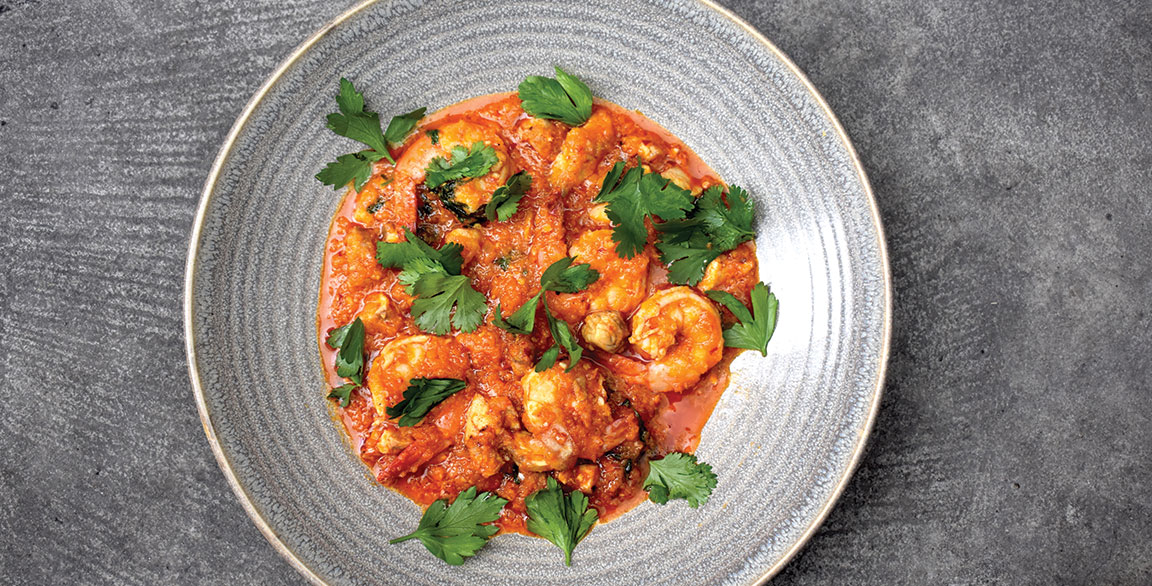

From creamy beurre blanc to smoky mole and aromatic curry, sauces are the building blocks of all types of global cuisines. With today’s driving curiosity in exploring more flavors, while staying in somewhat familiar territory, global sauces serve as a reliable flavor bridge.
Muramoto in Madison, Wis., offers a great example with its Ginger Flan. The customary format is paired with an adventurous sauce: salty miso caramel. The sauce not only provides unexpected flavor, but helps signaturize the dessert beautifully.
Of course, the enthusiastic embrace of bold sauces leads to a push for more global discovery, more American translation. Sauces from around the world that are starting to resonate with American diners vary from savory-hot sambal to sweeter-funkier nuoc cham and herby-sharp chermoula.
Our list of 12 do share a commonality—they all provide a punch of flavor, excitement and craveability.
1 Chermoula
Sometimes spelled “charmoula,” this bright herb sauce (or marinade) from North Africa features cumin as the main ingredient and is typically ground or blended into a paste with garlic, cilantro or other herbs, olive oil, salt and pepper. While chermoula is often used as a sauce accompaniment to seafood in countries like Algeria, Libya, Morocco and Tunisia, it can also shine in marinades for meats, as a topping for salads, bowls and other veg-centric builds, or as a spread or dip in a shareable.
- Pork Chop with shishito peppers and chermoula
—Louie, Clayton, Mo. - Seafood Chermoula with shrimp, mussels, Gulf fish, lemon, onion and olive oil
—Shaya, New Orleans - Lamb Tagine with braised lamb, chermoula vegetable couscous, farmer’s salad, marinated olives, yogurt mint sauce, scallions, fresh herbs and toasted almonds
—Saffron De Twah, Detroit
2 Tamarind Sauce
For chefs looking for pungent, sour and sweet flavors, tamarind answers the call. Common in both Thai and Indian cuisines, tamarind sauce (usually a blend of tamarind pulp or paste with fresh ginger, garlic, sugar, sambal, Thai fish sauce and soy sauce) is being used by chefs here as a high-impact ingredient for global mash-up versions of applications like glazes for chicken wings or ribs, drizzles for tacos and sauces for seafood dishes.
- Coconut Shrimp Toast drizzled with housemade tamarind sauce
—The Bamboo Club, Long Beach, Calif. - Baby Back Pork Ribs with soy-tamarind glaze and sesame seeds
—Wayan, New York
3 Makhani
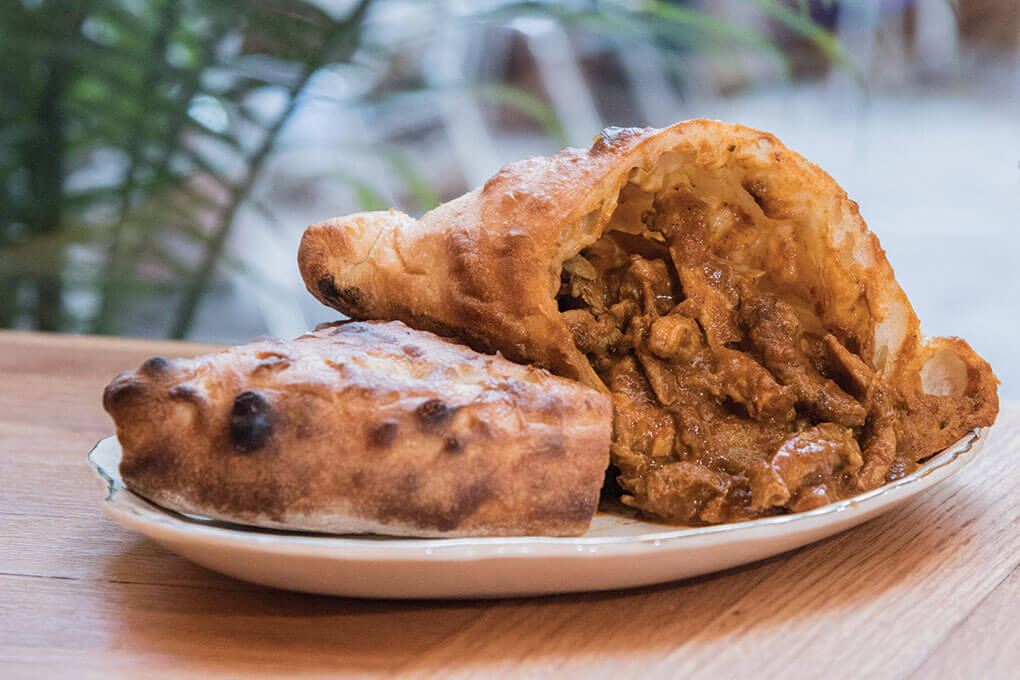 Superkhana International
Superkhana International Butter Chicken Supreme, starring makhani, is presented calzone-style at Superkhana International in Chicago.
This Indian curry (or gravy) is traditionally made by simmering green and red chiles, tomatoes, ginger, garlic, spices, nuts and seeds in plenty of butter and then grounding or blending it into a paste. As chef-driven modern Indian and Indian mash-up restaurants continue to pop up around the country, American consumers are becoming more familiar—and more enamored—with Indian flavors. Thanks to that, sauces like makhani are poised for growth. While makhani is classically used in paneer butter masala, chicken butter masala and egg or vegetarian Indian dishes, it can also be blended or used with other traditions and techniques, as in Italian-style calzones at Superkhana International in Chicago. It also adds a twist on pastas and pizzas as a red-hued, tomato-based alternative to marinara, or perhaps even in place of mole, another thick and simmered chile/nut sauce.
- Calzone-style Butter Chicken Supreme with makhani
—Superkhana International, Chicago - Paneer Pinwheel with red pepper makhani, fenugreek and pepperoncino
—Rooh, San Francisco
4 Savory Caramel
The resounding success of salted caramel has opened the doors to miso caramel and soy caramel. Each brings a wonderful complexity to desserts and savory dishes alike. Of course, we’re already seeing the combination of hot and sweet make a serious play, but this sweet-savory marriage offers a more tempered, nuanced experience.
- Miso Caramel Crab Roll with cream cheese and tempura preparation
—Lime House, Buffalo, N.Y. - Crispy Spiced Summer Squash with local tofu, wild rice, soy caramel
—The Tides Inn, Irvington, Va.
5 Nuoc Cham
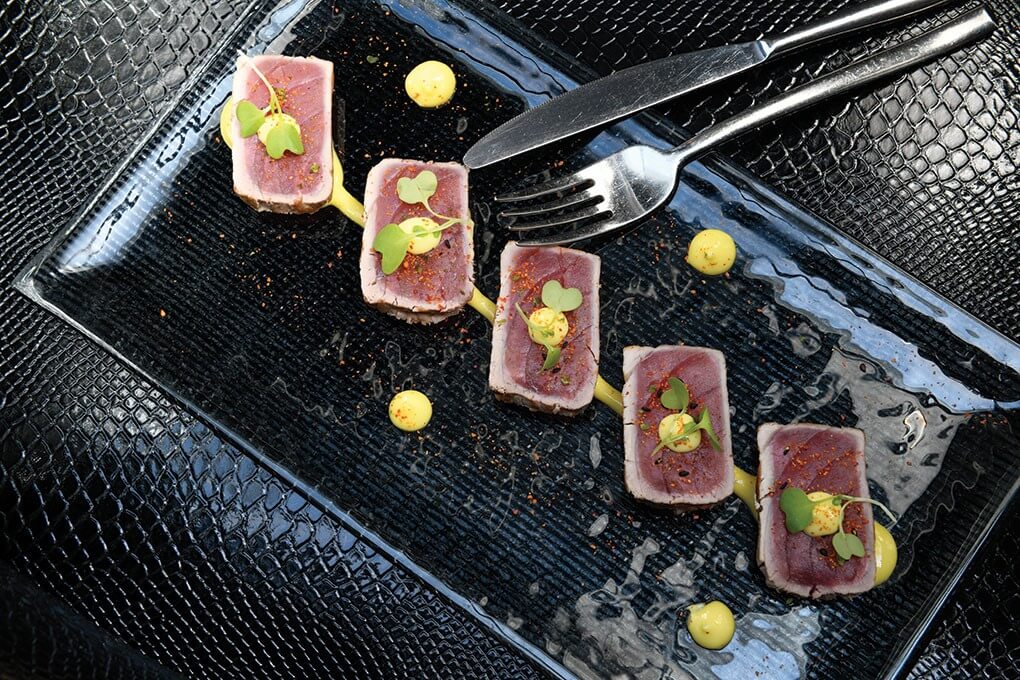 Dirty Habit
Dirty Habit At Dirty Habit in Washington, D.C., the Japanese-style Tuna Tataki with wasabi mayo and crispy sushi rice brings in a Southeast Asian touch with nuoc cham and sambal.
The unforgettable scene in the late Anthony Bourdain’s “No Reservations,” in which he shared a bowl of pork belly and nuoc cham with former President Barack Obama in Vietnam, helped boost the profile of the vinegar/fish/chile-based dipping sauce. The bright red, sweet and salty sauce complements delicate seafood dishes, and it can be used as a marinade for meat or drizzled over salads for a kick. Easy to apply beyond Vietnamese dishes, nuoc cham can also stand in for other condiments, thanks to its sweet and not-too-spicy approachability.
- Tuna Tataki with crispy sushi rice, wasabi mayo and nuoc cham/sambal sauce
—Dirty Habit, Washington, D.C. - Halibut Crudo with strawberries, Serrano, Marcona almonds, nuoc cham, cilantro
—Pearl 6101, San Francisco - Crispy Brussels Sprouts Salad with carrots, cilantro, red cabbage, almonds and nuoc cham vinaigrette
—Boru Ramen Bar, Kansas City, Mo.
6 Middle Eastern Hot Sauces
The name of the game here is bold, bright, big flavor. And just like with most hot sauces in the American culinary arsenal, chefs can apply Middle Eastern hot sauces across cuisines, mashing them into any number of modern dishes. Harissa is perhaps the biggest star, but a few others are making their way, too. First, s’chug is a wicked hot sauce with bright, acidic notes from cilantro and green chiles. Perfect with rich items like shawarma, it works equally well with tacos, wings and more. Another sauce to watch is shatta, a hot sauce common in Lebanese cuisine, which blends Kashmiri red chiles, lemon juice, garlic and chile powder.
- Falafel and Shawarma with optional spicy shatta hot sauce
—Pitaziki Mediterranean Grill, New Haven, Conn. - Kubaneh: Yemenite S’chug and grated tomato
—Nur, New York
7 Sambal
Sambal is a rising star among hot sauces, thanks to its bright, hot heat from chiles and lime juice, with just a touch of funkiness from its hint of shrimp paste. According to Datassential, menu mentions of sambal have gone up 47 percent over the last four years. Chefs are moving it beyond Southeast Asian applications and into global mash-ups and modern American builds.
- The Deeluxe Chicken Sandwich: Buttermilk fried chicken breast, apple-celery root slaw and sambal mayo
—DeeLuxe Chicken, Durham, N.C. - Shellfish & Sambal with mussels, shrimp, coconut and lemongrass
—Momofuku Ssäm Bar, New York
8 Yogurt-Based Sauces
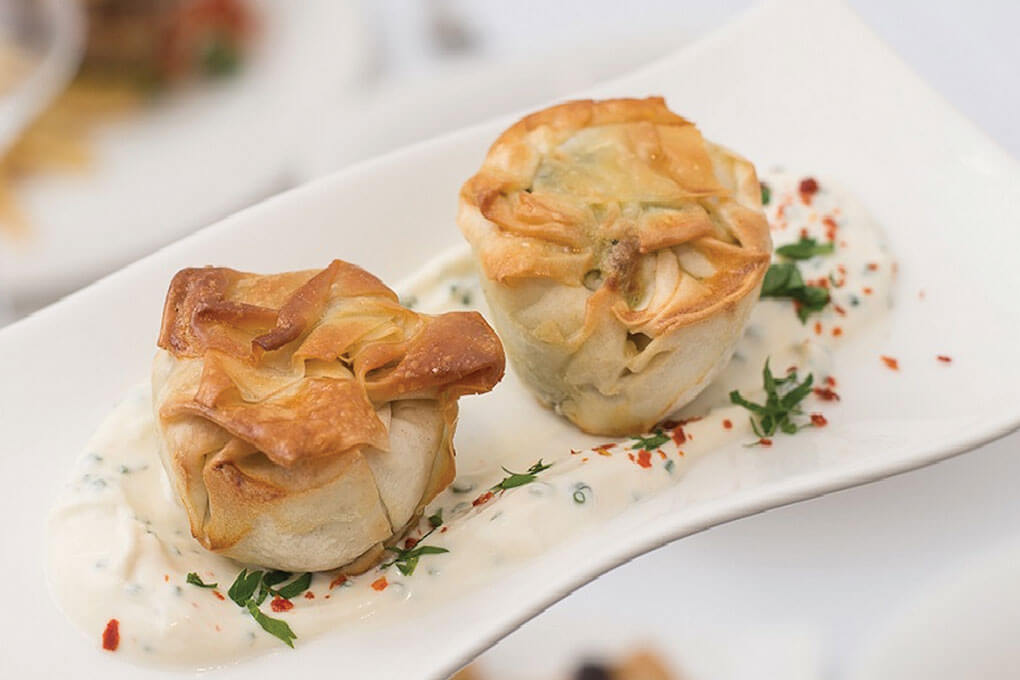 Nerai
Nerai Spanakopita at Nerai in New York is stuffed with spinach, artichokes, dill and feta cheese, and gets a modern update with ouzo-yogurt sauce.
As more chefs explore authentic and modern renditions of Eastern Mediterranean cuisines, the use of yogurt in sauces and spreads has grown tremendously. Of course, tzatziki paved the way, and chefs are now putting their spin on that classic yogurt sauce. They’re also playing with counterpoint, adding heat to yogurt with Sriracha or harissa, or adding a bit of smoke with guajillo or chipotle, for example. The beauty here is that with a growing familiarity of Eastern Med, diners are also more familiar with yogurt as a savory sauce, giving free rein to menu developers who want to use it outside of that cuisine’s parameters.
- Char-Grilled Broccoli with yogurt-based teklai garlic sauce, pickled shallots and nigella seed
—Lyra, Nashville, Tenn. - Fried Cauliflower with caper-yogurt sauce
—Kismet, Los Angeles - Spanakopita stuffed with spinach, artichokes, dill and feta cheese with ouzo yogurt sauce
—Nerai, New York
9 Nut-Based Sauces
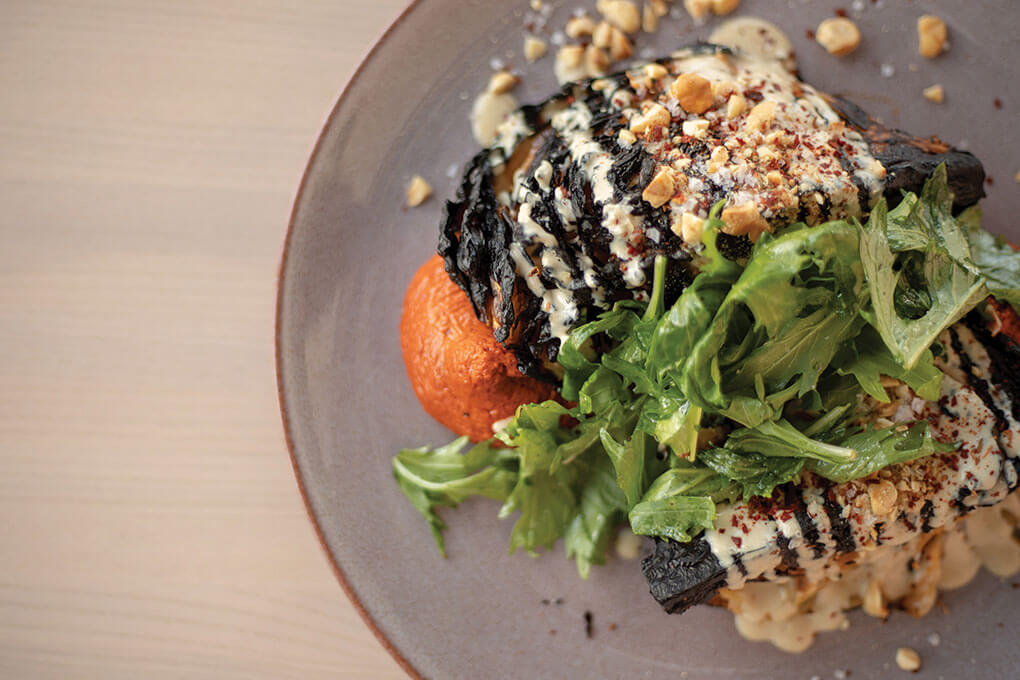 Mike Thurk
Mike Thurk At Safta in Denver, charred cauliflower gets a burst of color and flavor from muhammara, hazelnuts and Aleppo pepper.
As vegan fare becomes more mainstream—even among non-vegans—nut-based sauces are occasionally stepping in for dairy-based sauces. They’re also prevalent in various on-trend global cuisines. Both factors are driving menu innovation in this category. Two stars here are Spanish romesco, classically made with almonds and red pepper, and muhammara, a Syrian red sauce that traditionally sees walnuts, pomegranate, roasted red pepper and breadcrumbs. Chefs here are riffing on these sauces, making them their own or using them in unexpected formats.
- Charred Cauliflower with muhammara, hazelnuts and Aleppo pepper
—Safta, Denver - Mae Day Sandwich: Almond romesco, roasted veggies, feta, cucumber, arugula on Mae’s focaccia
—Mae’s, Marshfield, Mass.
10 Tahini
Tahini, that toasty, mild condiment made from ground sesame seeds, is moving beyond hummus and other Eastern Mediterranean dishes, going deeper into menu development. Partly driven by the proliferation of Eastern Med ingredients, and also by the fact that it’s a versatile plant-based, nut-free product, tahini is showing up in creative, enticing ways, often partnering with more familiar ingredients to locate that all-important comfort zone.
- Miso-glazed Eggplant with edamame, spicy greens, toasted peanuts and tahini yogurt
—Trade, Boston - Grilled Romaine Salad with tahini-Caesar dressing, capers, chives and sourdough breadcrumbs
—Bagel Uprising, Alexandria, Va.
11 Peri Peri
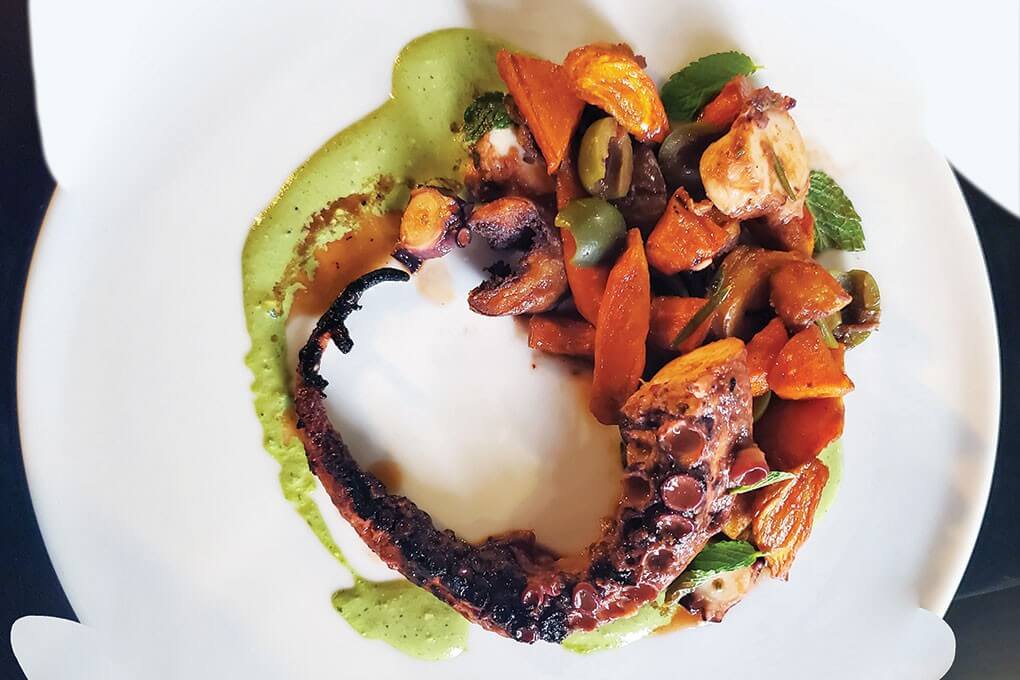 The Keep
The Keep Peri peri flavors the sous-vide octopus, served with olives and potatoes, at The Keep in Columbus, Ohio.
Peri peri (also spelled piri piri), a slightly sour and sweet spicy sauce made using African bird’s eye chiles, gained popularity in the United States through restaurants like Nando’s Peri-Peri, a South African-based chain serving up barbecue chicken marinated in the sauce. The true roots of the sauce are debated. Some claim its origins are in Portuguese cuisine, when settlers from that country came to Africa and blended their marinade of garlic, red wine vinegar, paprika and other spices with the bird’s eye chiles. Regardless, the sauce can be used as a spicier, more chile-forward alternative to sweet barbecue sauces for grilled, rotisserie or smoked dishes, as a dipping sauce for breads, or even spread on flatbread for a twist. Peri peri is also useful as a flavorful marinade for meats, meatier fish and vegetables.
- Falafel and chicken shawarma with choice of sauces, including peri peri
—Sajj Mediterranean, nine locations in California - Peri peri sous-vide octopus with olives and potatoes
—The Keep, Columbus, Ohio - Outsourced Taco: Tandoori chicken, peri peri, raita, tamarind salsa
—Urban Taqueria, Albuquerque, N.M.
12 Fruit-Based Sauces
Of course, chefs around the world know that fruit adds sweet, floral and textural notes to a sauce, helping round out richer dishes as well as those with a bit of spice. But today, chefs are taking it to a new level, either by reaching for more exotic produce or combining fruit with unexpected ingredients for intriguing global flavor combinations.
- Albacore Carpaccio with ponzu-jalapeño sauce
—The Spice Jar, San Francisco - Pan-Seared Duck Breast with toasted farro, fennel, orange segments, lemongrass-infused parsnip purée, and hibiscus, orange and pink peppercorn coulis
—The Signature Room at the 95th, Chicago
Of course, chefs around the world know that fruit adds sweet, floral and textural notes to a sauce, helping round out richer dishes as well as those with a bit of spice. But today, chefs are taking it to a new level, either by reaching for more exotic produce or combining fruit with unexpected ingredients for intriguing global flavor combinations.







